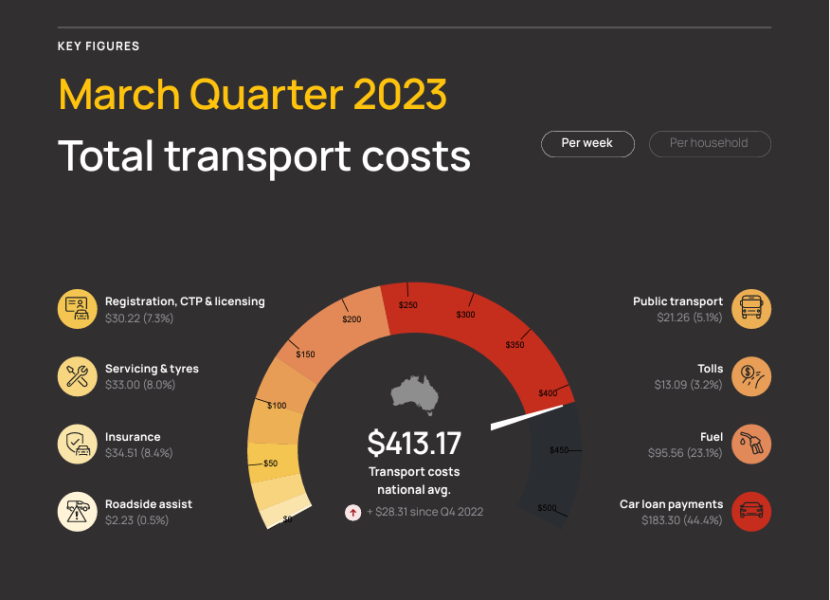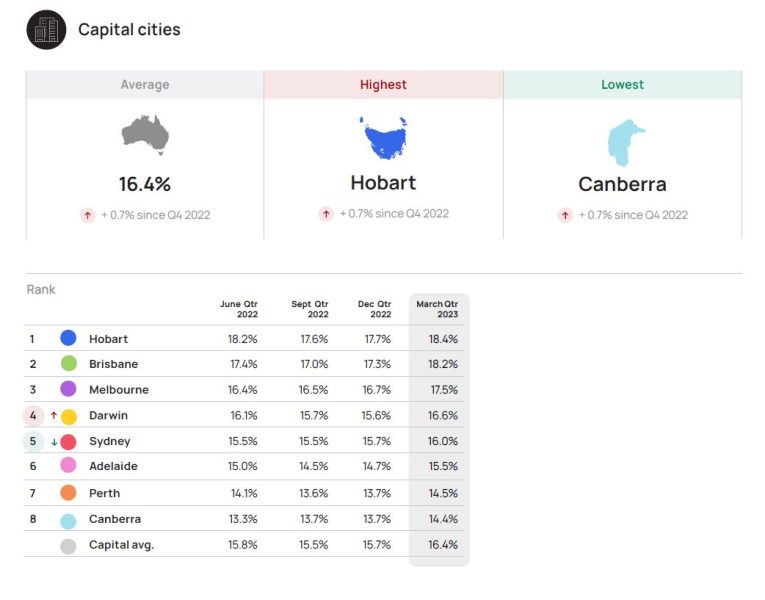
‘No ease on the squeeze’ according to the Transport Affordability Index
For your employeesWhile the debate continues about the effectiveness of the Reserve Bank of Australia’s use of interest rates to drive down inflation, the latest transport affordability snapshot, produced by the Australian Automobile Association (AAA) in partnership with SGS Economics and Planning, highlights continuing strain placed on the hip-pockets of working Australians.
Released In June, the AAA’s Transport Affordability Index for the March quarter of 2023 found that weekly transport costs grew by a sobering 7.4%, up from $384.86 per week in the December quarter to $413.17 (an extra $28.31 per week).
Managing Director of the AAA, Michael Bradley, says, “In the March 2023 quarter, the typical Australian household’s transport costs rose by almost 7.4[%]. This is much higher than the consumer price index increase of 1.4[%] over the same period. This rise was largely driven by higher up-front costs for purchasing new vehicles and the impact of rising interest rates on car loans.”
What is the Transport Affordability Index?
The Transport Affordability Index is a quarterly snapshot of the costs associated with keeping a car on the road for what the authors of the report described as “typical households in Australia”. It provides an important metric for showing how our transport costs change relative to income nationwide.
“It allows the AAA to assess the impact of proposed government policies on the average weekly budget,” the authors explain. “Families will also be better informed about how their decisions about transport affect their overall household budgets.”
In calculating these changes, the Index’s authors consider a wide range of costs that families face when they own a car, as well as any public transport charges. These costs fall into two broad categories: upfront costs and ongoing costs.
Upfront costs are those for the purchase of a new vehicle like car loan payments, registration, stamp duty, compulsory third party (CTP) insurance, driver licences, comprehensive car insurance premiums, and roadside assistance. Ongoing costs include factors such as fuel, tolls, and car maintenance, with these costs increasing the more the vehicle is driven. Public transport costs for a city household’s typical commute to work are also measured because these form a growing share of weekly expenses.
Importantly, the report doesn’t include depreciation in its index. As the authors explain, “While the AAA recognises that vehicle depreciation represents a significant, often hidden, cost to families, this cost has not been included in the Index.”
“The Index seeks to account for the actual weekly transport cash outflow for an average Australian household, covering costs that must be factored into the weekly family budget; depreciation is not usually accounted for in this way,” they rationalise. “Similarly, parking costs have not been included in the Index because consistent data is not available.”
Transport affordability: Where your money’s going
The latest Index provides the following breakdown of how the $413.17 per week (on average) gets divvied up to keep your car on the road:

(Source: Transport Affordability Index: March Quarter 2023, p.3)
Car loan repayments make up the largest chunk of the average weekly costs at $183.30; a massive 44% impost, with fuel being the next biggest at $95.56 per week (23.1%).
Insurance costs accounted for almost 8.5% of the weekly spend at $34.51, with servicing and tyres costing $33 (8%); registration, CTP and licensing $30.33 per month (7.3%); public transport $21.26 (5.1%); tolls $13.09 (3.2%); and roadside assistance packages $2.23 (0.5%).
Transport affordability state-by-state
Sydney remained the most expensive city in Australia for transport affordability, with the annual cost sitting at $26,562. Melbourne isn’t far behind, recording an annual figure of $26,142; followed by Brisbane on $26,142, Canberra on $22,200, Perth $21,641, Adelaide $21,459 and Darwin on $21,360. Hobart has the cheapest transport affordability with their annual cost sitting at $20,311.
The biggest annual rise in affordability was recorded by Darwin, with an 8.32% increase from $19,719, to $21,360. Families in Canberra also saw a sharp jump from $20,590 to $22,200 – a 7.8% rise in affordability.
While Hobart retains the ‘most affordable’ annual transport affordability figure among Australia’s capital cities at $20,311, this represents an equally painful increase of 7.52% for Australia’s southernmost major city – up from the December quarter figure of $18,890, the third highest increase for the period – with Brisbane’s 7.34% increase and Melbourne’s 7.27% hot on Hobart’s heels.
Increases of 6.22% and 6.16% were recorded in Adelaide and Perth respectively and, while topping out the list with the worst transport affordability figure, Sydney saw the lowest increase for the quarter of only 3.71%
|
|
Dec Qtr | March Qtr | Rise | % +/- |
|
Darwin |
$19,719 | $21,360 | $1,641 |
8.32% |
| Canberra | $20,590 | $22,200 | $1,610 |
7.82% |
| Hobart | $18,890 | $20,311 | $1,421 |
7.52% |
| Brisbane | $24,239 | $26,027 | $1,788 |
7.38% |
|
Melbourne |
$24,371 | $26,142 | $1,771 |
7.27% |
|
Adelaide |
$20,203 | $21,459 | $1,256 |
6.22% |
|
Perth |
$20,385 | $21,641 | $1,256 |
6.16% |
| Sydney | $25,611 | $26,562 | $951 |
3.71% |
(Source: Transport Affordability Index: March Quarter 2023, p.4)
The cumulative effect of continually rising transport costs is a heavy burden at a time when Australians are feeling cost-of-living pressures across the board” notes Michael Bradley of the AAA. “Transport is a significant and unavoidable expense for households, and is one of the key drivers of inflation.”

(Source: Transport Affordability Index: March Quarter 2023, p.8)
Novated leasing helps affordability
Novated leasing has long been an effective and popular employee benefit to help with the ongoing struggle to retain and attract high-performing staff. And, as the cost-of-living crisis continues here and in many of the world’s developed economies, an effective novated leasing program will be an even more effective way to put more money in your employee’s pockets at a time when they really need it.*
Your staff can choose the car they want and bundle the finance and all the expected running costs into a single payment that’s deducted from pre-tax salary.
This can mean they pay less income tax, and save GST on the car purchase price and running costs.
Everything to keep the car running – including maintenance, repairs, tyres, registration, and fuel – can be bundled into the salary deductions.
Plus, with the recent Electric Car Discount Bill, there can be thousands of dollars in extra savings on eligible electric vehicles with FBT exemptions.
In conclusion
Continued increases in the RBA’s official cash rates and global inflation spikes are having a drastic impact on the cost of living for many families. Households are feeling the pinch on their weekly budget in many ways, and the figures contained in the AAA’s latest Transport Affordability Index confirm there’s little relief likely when it comes to transportation.
For businesses seeking to provide real benefits to staff, giving them the opportunity to take on a novated lease on a new vehicle might be the a way to do something that can help relieve some of the cost pressures on essential transport.
Looking to create a novated leasing program for your business? Start a conversation with SG Fleet today.
*An important caveat with any discussion about novated leasing is that one person’s tax situation will be different to someone else’s. What we’ve discussed here is general information. That’s why anyone weighing up the pros and cons of a novated lease should always get independent advice from their tax advisor or accountant on how a novated lease will work specifically for them.
 Driving Insights
Driving Insights



